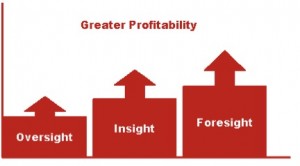Of course, the ultimate goal of any business is to create profitability for its owners, shareholders,  and stockholders. Without profitability, the business will cease to exist.
and stockholders. Without profitability, the business will cease to exist.
To quote Kenny Rogers, sometimes you need to know when to hold up and when to fold up, though. There are times when a company is in a significant competitive situation where it needs to go into the market guns a-blazing and grab as much market share and mind share as it can.
In the market we’re in right now, some might think the worst is over. They may think it’s time to start “milking” the business trying to extract as much profitability as they can. WRONG Answer! I have lived this dream myself so I would like to give all business owners and leaders a piece of advice learned in the School of Hard Knocks.
If your market share is not growing then it is actually declining, even if your market share is significant. If you’re not getting better you’re actually getting worse, because there are others that are getting better around you. Business marketplaces are not static. There is always someone gaining and someone losing. If you’re “stable” that means you’re actually losing because there’s someone else that is growing.
Here are some signs that you’re falling into the profitability over market share trap.
- You fundamentally believe that it’s okay to have stable market share and don’t consistently chase growth
- Customer service is left up to each individual agent or customer support manager – you’re not measuring the company’s customer satisfaction scores on a regular basis because the customer “isn’t equipped to provide educated feedback about what we do”.
- You’ve decided to spend LESS on customer-facing programs because your market share is stable and strong
- You’re decided to invest LESS in training or technology because you have invested heavily in the past couple of years
- The core focus of the company is to find to make your internal processes more efficient
We work with technology companies that tell us their key focus is to make their marketing dollar work harder. While I applaud a constant evaluation of marketing effectiveness, if you are too worried about not wasting one dollar you’re going to miss out on opportunities. If you have an aggressive competitor they’re going to invest in a diverse array of programs, especially if they sense that you are not doing the same. They’re going to take credit for their investment with your shared customers too and use it against you. When you’re in a dog fight the last thing you want to do is get conservative. You have to go for it – even if that means a hit to the bottomline in the short term.
When I was at Fisher-Price, we had a couple of leaders that drove the company away from creating products that delighted toddlers and preschoolers and more to cutting corners on quality and play value with the goal of creating a lower cost of goods and higher product margins. While we saw a short-term gain in profitability, we very quickly saw a significant LOSS in market share which had a devastating effect on profitability. Why? Because the toys were not as fun to play with anymore… The hold times were a lot longer on the customer support lines. The toys would wear out more quickly because the quality was not as high. On paper, the company looked more profitable for a few quarters. Then the story started to unravel. Wal-mart cut back on the amount of shelf space it gave us because the toys were not selling as well as they used to. Innovation started to wane and our competitors had more exciting toys than we did. Consumers started to abandon us because we had betrayed their trust. They always thought of Fisher-Price as the company with the highest product quality and best customer service. Companies that forget that they need to delight their customers are the first ones to fall.
We see the same phenomenon with some brokerages in our own industry. Some companies, especially the larger ones like to power their way through, leveraging their market share, not their customer-centricity. While a strong brand and leadership position are very important, the old adage can be true. The bigger they are, the harder they fall. Every company needs to remain nimble and flexible, constantly challenging their conventional thinking and marketing approach. The smartest companies are ALWAYS testing new ideas – maybe in one office, maybe in one market, maybe even with just one agent, but they are ALWAYS testing….questioning if there’s a better way to run the railroad. If your company is not always trying something new, then you’re missing opportunities to create a competitive advantage.
If you find yourself these days focusing more on how to create profitability than how to create fantastic customer relationships and the most compelling marketing programs and technologies to nurture those relationships, then you’re falling behind – and you may not even know it yet. The effects may be felt in a few months, few quarters or even a few years, but you’re going to lose even more profitability if your focus is more about bottom-line than your customers.
The true path to profitability to not a straight line. Smart companies watch their company’s customer metrics closely. They don’t just measure deal flow. They measure customer satisfaction and retention. They are constantly gaining new insights about better ways to serve the needs of their customers and then they are smart about communicating those unique strengths to their customers. Most importantly, they are keeping their ear to the ground – looking at changing trends in the economy, customer need, employee satisfaction and technologies. They are “ON IT” – not assuming just because it has worked in the past it is going to work in the future.
Good luck finding your circuitous path to profitability by finding ways to consistently grow your market share!






Leave A Comment